Abstract
Two hundred and thirty-four lead workers employed in a storage battery factory in Korea were examined for lead in blood (PbB) and urine (PbU). delta-aminolaevulinic acid in urine (ALAU), coproporphyrin in urine (CPU), and haemoglobin. The dose-response relationship between PbB and ALAU suggested that a PbB below 50-60 micrograms/dl is a proper practical limit of biological monitoring for lead workers. The inter-relationship between PbB and ALAU or PbU was better explained by a segmental straight function than by a curvilinear function. Inclusion of data from workers whose PbB was below 30-40 micrograms/dl, if they comprise a relatively large proportion of the whole, seems to have a role as a dummy effect on the overall regression function causing the curvilinear trend. At a given blood lead concentration, the ALAU of lead workers increased with an increase in the duration of exposure. This could be explained by the chronic effect of lead on haem precursors. Semi-quantitative measurement of CPU still played an important part in the screening of lead workers due to its simplicity, showing high sensitivity (97.8%) in detecting lead workers with PbB of 60 micrograms/dl or over.
Full text
PDF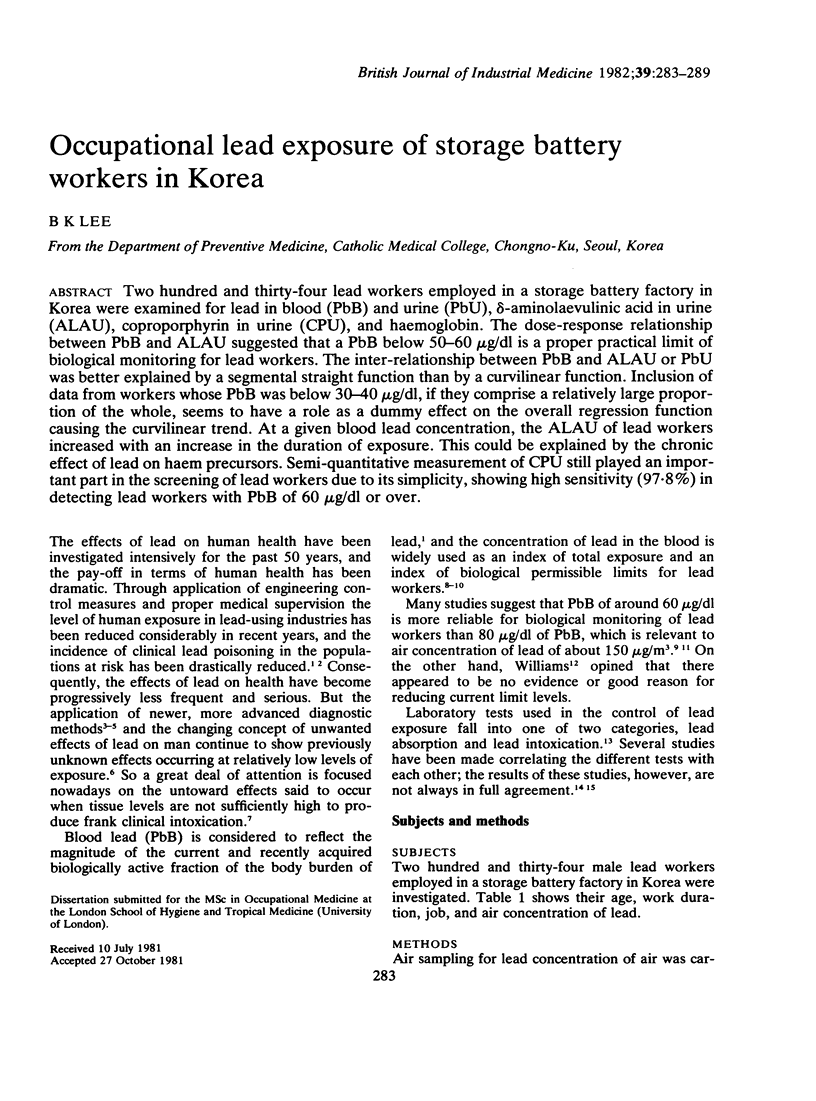
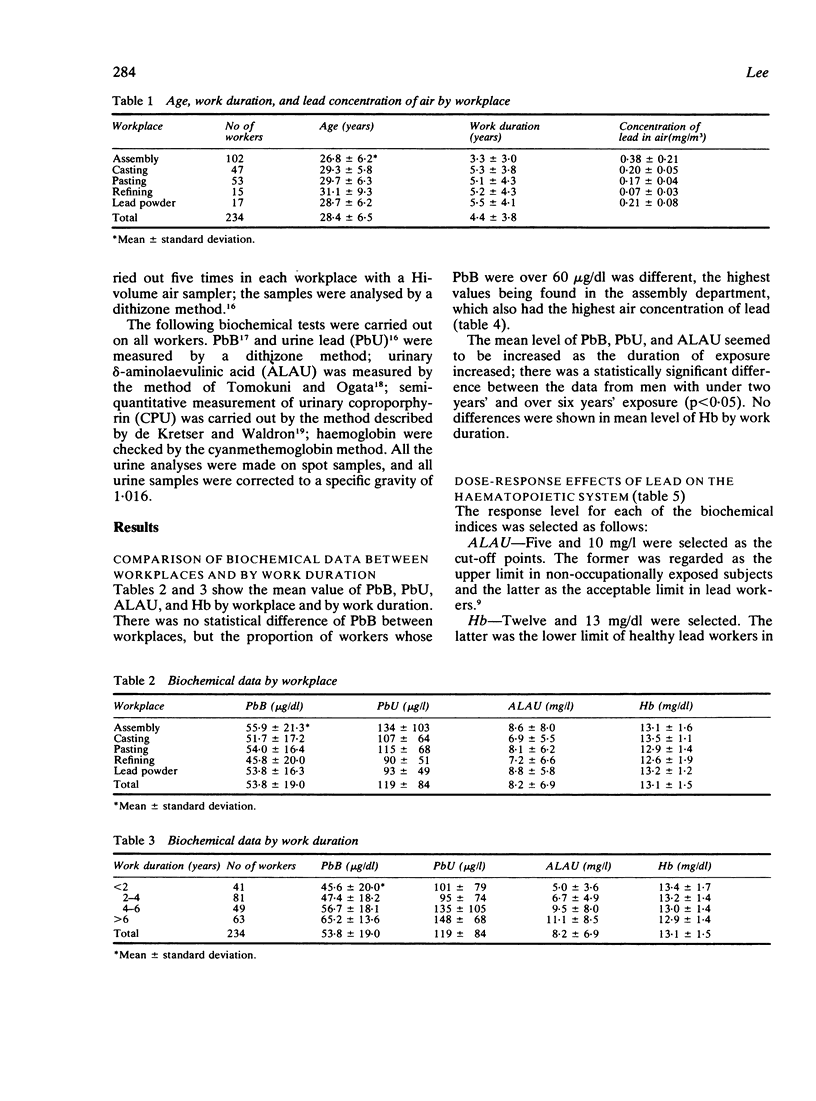
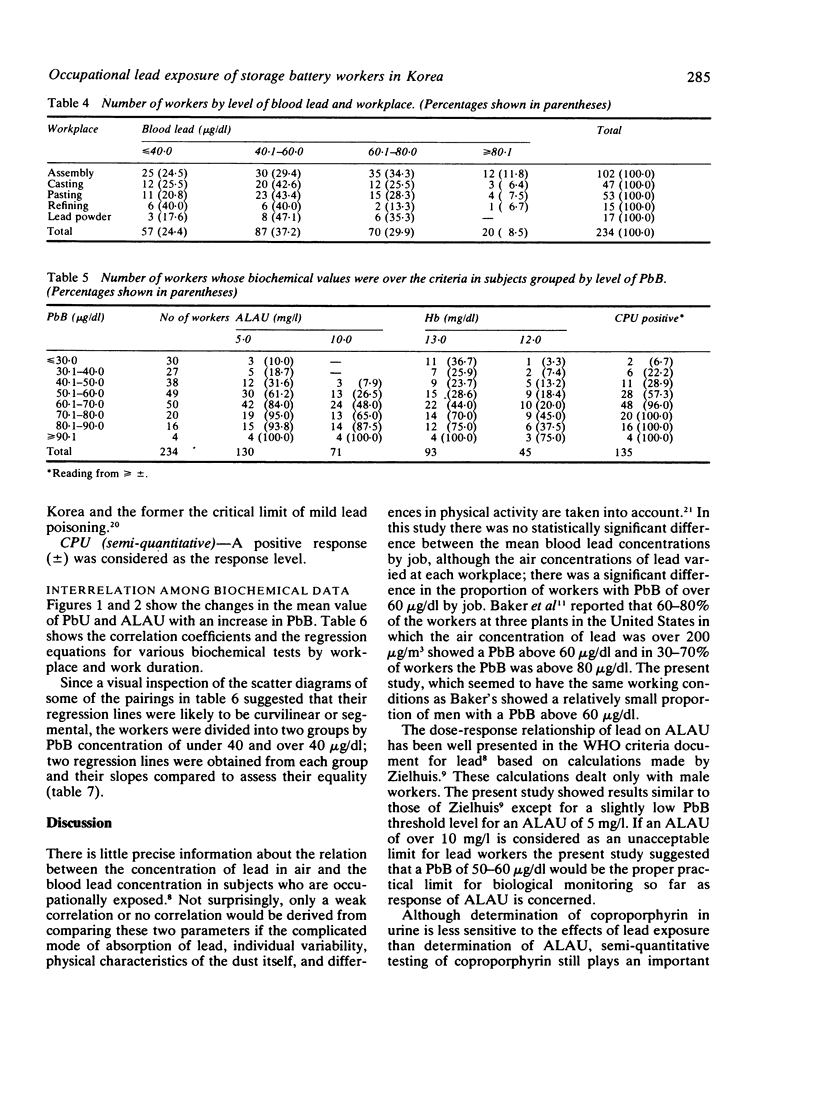
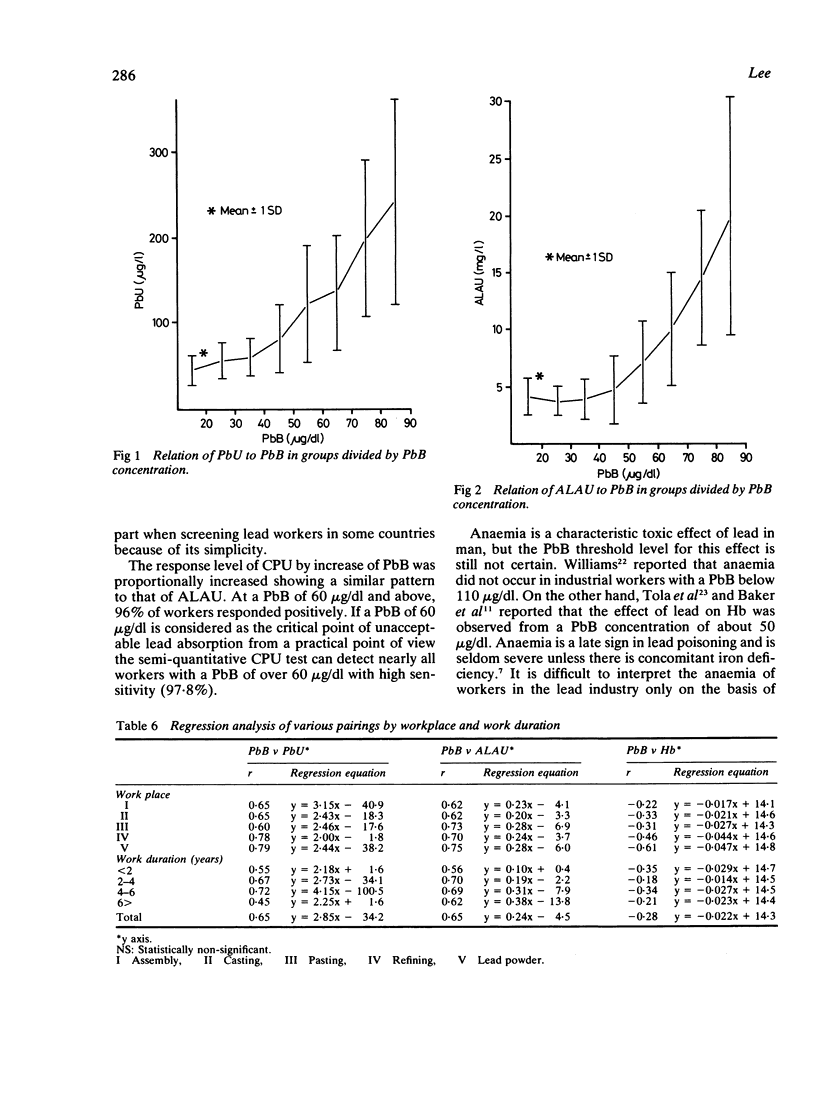
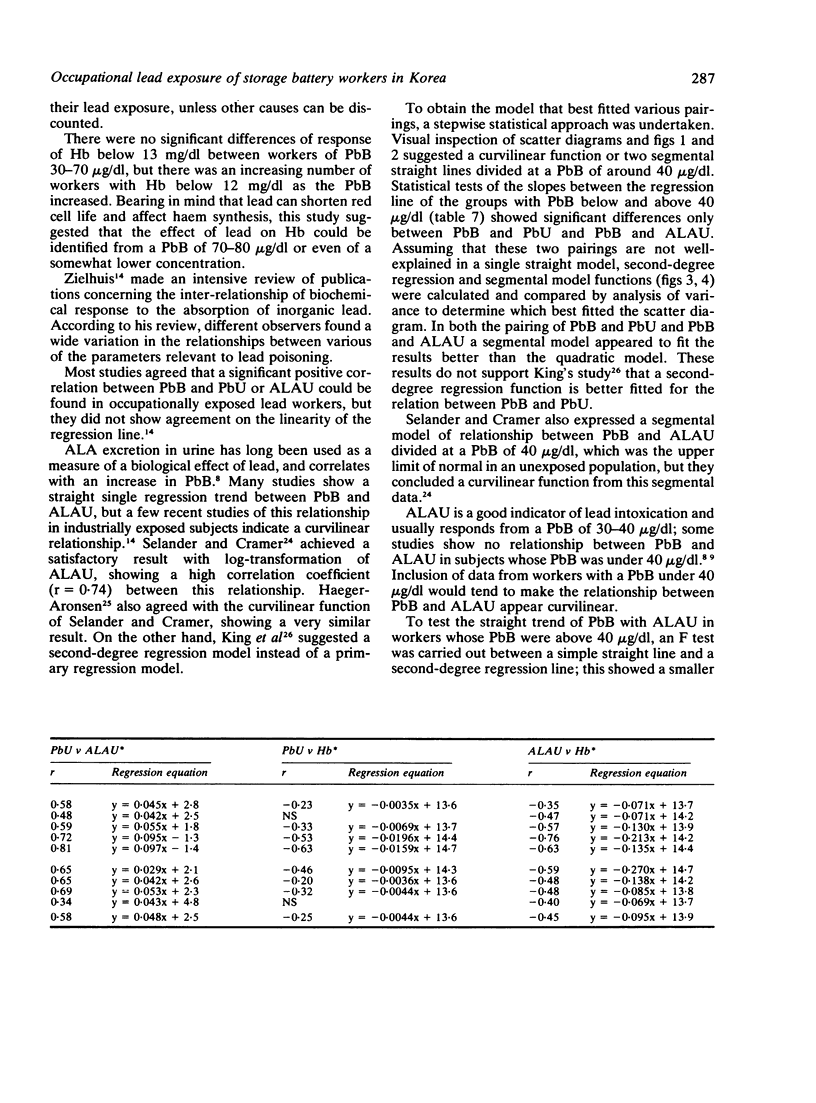

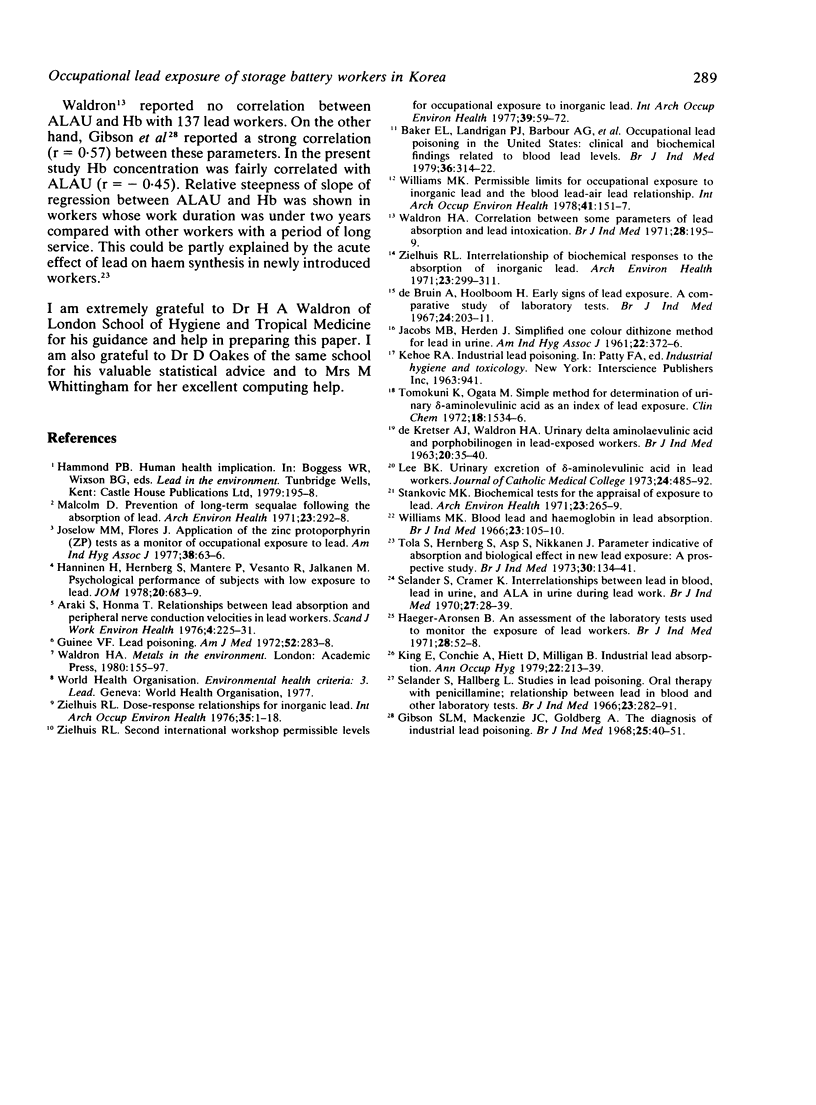
Selected References
These references are in PubMed. This may not be the complete list of references from this article.
- Araki S., Honma T. Relationships between lead absorption and peripheral nerve conduction velocities in lead workers. Scand J Work Environ Health. 1976 Dec;2(4):225–231. doi: 10.5271/sjweh.2800. [DOI] [PubMed] [Google Scholar]
- Baker E. L., Jr, Landrigan P. J., Barbour A. G., Cox D. H., Folland D. S., Ligo R. N., Throckmorton J. Occupational lead poisoning in the United States: clinical and biochemical findings related to blood lead levels. Br J Ind Med. 1979 Nov;36(4):314–322. doi: 10.1136/oem.36.4.314. [DOI] [PMC free article] [PubMed] [Google Scholar]
- DE KRETSER A. J., WALDRON H. A. Urinary delta aminolaevulinic acid and porphobilinogen in lead-exposed workers. Br J Ind Med. 1963 Jan;20:35–40. doi: 10.1136/oem.20.1.35. [DOI] [PMC free article] [PubMed] [Google Scholar]
- De Bruin A., Hoolboom H. Early signs of lead-exposure. A comparative study of laboratory tests. Br J Ind Med. 1967 Jul;24(3):203–212. doi: 10.1136/oem.24.3.203. [DOI] [PMC free article] [PubMed] [Google Scholar]
- Gibson S. L., Mackenzie J. C., Goldberg A. The diagnosis of industrial lead poisoning. Br J Ind Med. 1968 Jan;25(1):40–51. doi: 10.1136/oem.25.1.40. [DOI] [PMC free article] [PubMed] [Google Scholar]
- Guinee V. F. Lead poisoning. Am J Med. 1972 Mar;52(3):283–288. doi: 10.1016/0002-9343(72)90015-0. [DOI] [PubMed] [Google Scholar]
- Haeger-Aronsen B. An assessment of the laboratory tests used to monitor the exposure of lead workers. Br J Ind Med. 1971 Jan;28(1):52–58. doi: 10.1136/oem.28.1.52. [DOI] [PMC free article] [PubMed] [Google Scholar]
- Haenninen H., Hernberg S., Mantere P., Vesanto R., Jalkanen M. Psychological performance of subjects with low exposure to lead. J Occup Med. 1978 Oct;20(10):683–689. [PubMed] [Google Scholar]
- JACOBS M. B., HERNDON J. Simplified one color dithizone method for lead in urine. Am Ind Hyg Assoc J. 1961 Oct;22:372–376. doi: 10.1080/00028896109343424. [DOI] [PubMed] [Google Scholar]
- Joselow M. M., Flores J. Application of the zinc protoporphyrin (ZP) test as a monitor of occupational exposure to lead. Am Ind Hyg Assoc J. 1977 Feb;38(2):63–66. doi: 10.1080/0002889778507915. [DOI] [PubMed] [Google Scholar]
- King E., Conchie A., Hiett D., Milligan B. Industrial lead absorption. Ann Occup Hyg. 1979;22(3):213–239. doi: 10.1093/annhyg/22.3.213. [DOI] [PubMed] [Google Scholar]
- Malcolm D. Prevention of long-term sequelae following the absorption of lead. Arch Environ Health. 1971 Oct;23(4):292–298. doi: 10.1080/00039896.1971.10666004. [DOI] [PubMed] [Google Scholar]
- Selander S., Cramér K., Hallberg L. Studies in lead poisoning. Oral therapy with penicillamine: relationship between lead in blood and other laboratory tests. Br J Ind Med. 1966 Oct;23(4):282–291. doi: 10.1136/oem.23.4.282. [DOI] [PMC free article] [PubMed] [Google Scholar]
- Selander S., Cramér K. Interrelationships between lead in blood, lead in urine, and ALA in urine during lead work. Br J Ind Med. 1970 Jan;27(1):28–39. doi: 10.1136/oem.27.1.28. [DOI] [PMC free article] [PubMed] [Google Scholar]
- Stanković M. K. Biochemical tests for the appraisal of exposure to lead. Arch Environ Health. 1971 Oct;23(4):265–269. doi: 10.1080/00039896.1971.10665997. [DOI] [PubMed] [Google Scholar]
- Tola S., Hernberg S., Asp S., Nikkanen J. Parameters indicative of absorption and biological effect in new lead exposure: a prospective study. Br J Ind Med. 1973 Apr;30(2):134–141. doi: 10.1136/oem.30.2.134. [DOI] [PMC free article] [PubMed] [Google Scholar]
- Tomokuni K., Ogata M. Simple method for determination of urinary -aminolevulinic acid as an index of lead exposure. Clin Chem. 1972 Dec;18(12):1534–1538. [PubMed] [Google Scholar]
- Waldron H. A. Correlation between some parameters of lead absorption and lead intoxication. Br J Ind Med. 1971 Apr;28(2):195–199. doi: 10.1136/oem.28.2.195. [DOI] [PMC free article] [PubMed] [Google Scholar]
- Williams M. K. Blood lead and haemoglobin in lead absorption. Br J Ind Med. 1966 Apr;23(2):105–111. doi: 10.1136/oem.23.2.105. [DOI] [PMC free article] [PubMed] [Google Scholar]
- Williams M. K. Permissible limits for occupational exposure to inorganic lead and the blood lead--air lead relationship. Int Arch Occup Environ Health. 1978 May 12;41(3):151–157. doi: 10.1007/BF00572887. [DOI] [PubMed] [Google Scholar]
- Zielhuis R. L. Dose-response relationships for inorganic lead. I. Biochemical and haematological responses. Int Arch Occup Environ Health. 1975 Jul 11;35(1):1–18. doi: 10.1007/BF01266323. [DOI] [PubMed] [Google Scholar]
- Zielhuis R. L. Interrelationship of biochemical responses to the absorption of inorganic lead. Arch Environ Health. 1971 Oct;23(4):299–311. doi: 10.1080/00039896.1971.10666005. [DOI] [PubMed] [Google Scholar]
- Zielhuis R. L. Second international workshop permissible levels for occupational exposure to inorganic lead. Int Arch Occup Environ Health. 1977 Jun 30;39(2):59–72. doi: 10.1007/BF00380886. [DOI] [PubMed] [Google Scholar]


